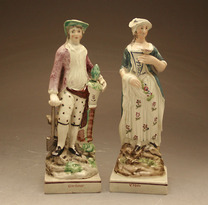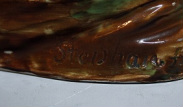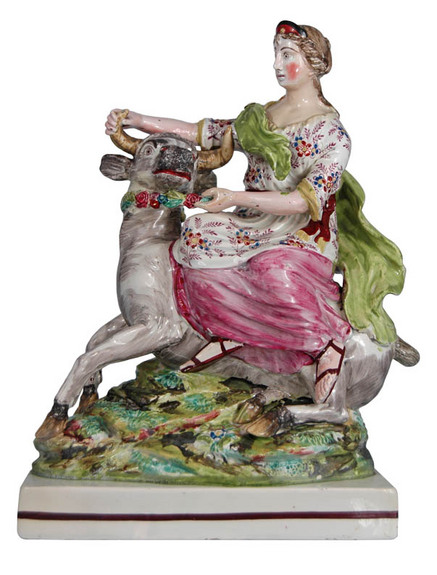Chetham & Woolley? They didn’t make figures...or did they? Busts yes, but figures? Bob clearly was a step ahead of me this time, and I couldn’t wait for the pictures to arrive. So here she is.
Let’s look at the types of earthenware bodies. Bob referred me to Colin Wyman’s Chetham & Woolley Stonewares 1793-1821 for a very concise clarification of this otherwise murky area.
- Earthenware (pottery to most of us) comprises mixed clays. When fired, it is gritty and porous. Unless it is glazed, water will seep into it. It is not translucent.
- Stoneware uses a modified clay mix able to withstand even higher firing temperatures. The body is vitreous (glassy) and fine. It is not translucent.
- Feldspathic stoneware comprise a clay mix with more feldspar in it. With high firing temperatures, it yields a stoneware body that is translucent.
Bob’s figure is feldspathic stoneware. Possibly Chetham and Woolley made it. This firm established its potbank in Longton in 1795 and pioneered feldspathic stoneware, a new earthenware body that was translucent. The blue line around the base of Charity is like that found on soccles supporting busts made by this manufactory. I know an attribution can’t be hung on a blue line, but the line is a slim clue pointing us in a direction.
Although I have seen many versions of Charity, this form appears to be unique. I have seen no other example modeled thus. The molds are of a high standard and must have been costly, so it is difficult to understand why we don’t see other figures from them.
I can only conclude that Bob’s Charity was an experimental attempt, possibly by Chatham and Woolley. If you have any thoughts on this figure, please share.
Note
The only other figures I have recorded with a blue line around the base are the Seasons (discussed on July 27 2011, accessiible here) and a soldier. The decoration on the figures was suggestive of Ralph Wood but insufficient basis for attribution. At best, I must conclude that a painter who had worked for Wood may have painted these figures too. The figures are ordinary stoneware—not translucent, as best I can assess. They have pearlware glazes and in all other aspects resemble earthenware Staffordshire figures.
Update:
The figures had languished in a cabinet for some considerable time but I had resisted the temptation to buy them because of the price.
When I finally decided I must have them guess what, they had been sold just two days before! How man times have we done that......?
In over 40 years of collecting pots I can only recollect seeing a handful of these feldspathic figures.
Great information....and a reminder to always seize the moment!
































